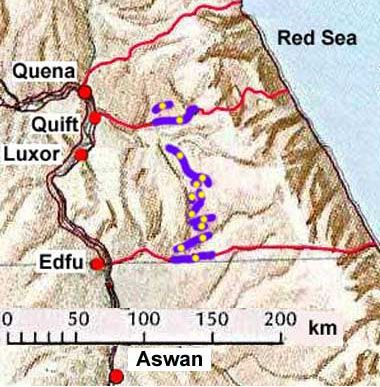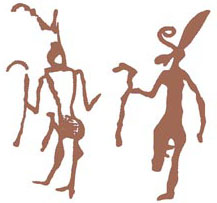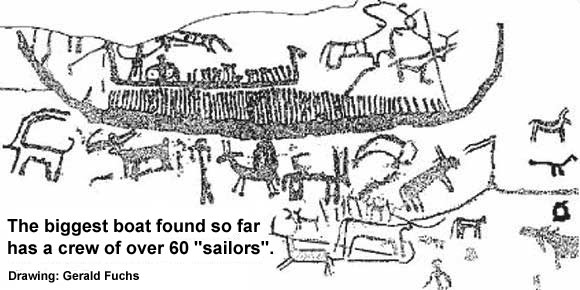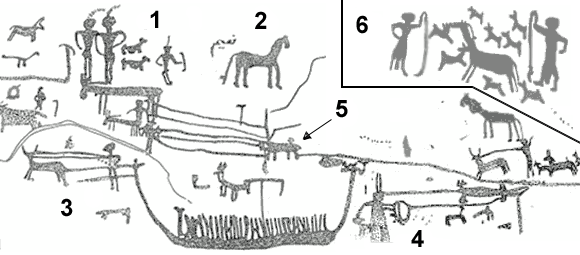
|
The motifs are boats, people and animals. Most common are the Ibex antelope (66%), cattle (40%), elephants (13%), crocodiles/hippos (6% each) and giraffes, sheep, goats, dogs, unidentified animals, figures, signs, lines, etc.
Hunting scenes (and maybe domesticating) are frequent. Most remarkable are all the boats, which are present in all major engravings.
If they reflect the origin of the artists is hard to tell, but their ancestors might possibly once have lived by the Nile and for some reason moved to the mountains, since this connection westwards is obvious.
 |
Some of the enlarged human shaped figures are very much like the ones found on predynastic pottery from the Nile Valley, and seem to reflect gods and goddesses rather then human beings. Notable is that as soon as the Egyptian state was founded in c. 3.200 BC, this rock art wasn't made any more, and very few pictures produced in dynastic times and later are found.
If, how and why the new state by the Nile effected these mountain nomads, and if they participated in its foundation, is a question to be solved through archaeology. No planned diggings of substance has yet (year 2009) been made in this area where people lived well into the New Kingdom 2.000 years later, and then disappeared in a strange way.
 Different types of boats. The crescent formed vessels are believed to be made of wood and the ones with high prows of papyrus (or reed). At far right: a small nomading family group. |
 Big (a good 2 m) vessel with no cabin. The "captain's" legs visible at the left end. Smaller ship atop has two figures on board. At the right side is possibly two pennants on a pool. |
 1) Dancers and archer with two dogs aiming at 2) a horse-like animal. 3) The boat pulled? by a man with ropes around an animal's horn. 4) A man with dog in a leash and a drum? holding a crocodile by two ropes. 5) A similar motif with a man holding (capturing?) an un- identified animal). 6) Lassoing? a donkey with attacking dogs or herdsmen with crooks? |
 Lizard, hippo and giraffes. Boats from the trail Wadi Hammamat in map starting from Quift. |
Real scientific examinations of this rock art started by a German scholar in the 1930s and then halted until the 1980s and has been ongoing since then, and increasing.
Estimations of its age have been made through different methods but has just roughly been able to give a time span. In some sites pictures have been added over the years making it extra hard to date with components from different periods. C14 analysis of paint has not been made and just a single picture is known to have colors added.
The best way to date these objects is to compare them to the ones from the Nile Valley which are classified in age. Especially two types are useful and clearly tied to one another and it's the boats and the loop-armed figures. Other motifs are not very similar (or even present) in both places. Why almost every site have just a few pictures with this connection within the same engraving, is another tricky question.
 The difficulties in dating the rock art (left) to pottery from the Nile Valley. The "dancers" and cabins are similar, but the hull of the boats are different. This pottery is from 3,300-3,200 BC. just prior to the advent of the Egyptian state. Far left: hunting motif and domestication(?). |
The motifs in the picture above are quite similar and the boat to the left is probably made of reed or papyrus and the other one (at least partly) of wood. It's possible that the wooden vessel (of a type never seen on eastern rocks) is the most resent made, when technology made it possible to use this material. Thus the rock carving might be slightly older.
Rock art experts are well provided with stuff to examine, and during a scouting expedition in 2006 the expected numbers of new pictures to be found was around 100. The result came to be over 1,000(!) and the locations must be kept a secret to the public to avoid damaging.
Earthly remains from the mountaineers themselves are still to be found by archaeologists willing to dig rather then examine rocks. For the moment (year 2009) restrictions due to security and other matters is obstructing scholar willing to do so.
